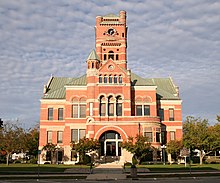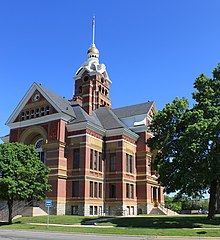| Revision as of 05:58, 23 February 2018 editMcGhiever (talk | contribs)Autopatrolled, Event coordinators, Extended confirmed users, Pending changes reviewers29,199 edits →See also: -Church of St. Francis Xavier (Benson, Minnesota): different Fallis← Previous edit | Revision as of 13:45, 1 October 2018 edit undoSer Amantio di Nicolao (talk | contribs)Autopatrolled, Administrators6,286,293 editsm add authority control, testTag: AWBNext edit → | ||
| Line 23: | Line 23: | ||
| |date= 2002 | |date= 2002 | ||
| |accessdate= 28 April 2017 }} | |accessdate= 28 April 2017 }} | ||
| </ref> | |||
| ==See also== | ==See also== | ||
| Line 31: | Line 31: | ||
| ==References== | ==References== | ||
| {{reflist}} | {{reflist}} | ||
| {{authority control}} | |||
| {{DEFAULTSORT:Fallis, Edward Oscar}} | {{DEFAULTSORT:Fallis, Edward Oscar}} | ||
Revision as of 13:45, 1 October 2018


Edward Oscar Fallis, often known as E.O. Fallis, was an American architect of Toledo, Ohio.
A number of his works are listed on the U.S. National Register of Historic Places.
Works include (with attribution):
- First Church of Christ, Scientist, 2704 Monroe St. Toledo, OH (Fallis,E.O.;Yost & Packard), NRHP-listed
- One or more works in Fountain City Historic District, roughly bounded by Butler, Lynn, W. Wilson, Center, Portland and Beech Sts. Bryan, OH (Fallis,E.O.), NRHP-listed
- Benjamin F. Kerr House, 17605 Beaver St. Grand Rapids, OH (Fallis,Edward O.), NRHP-listed
- Lenawee County Courthouse, 309 N. Main St. Adrian, MI (Fallis.Edward O.), NRHP-listed
- Noble County Courthouse, Courthouse Sq. Albion, IN (E. O. Fallis & Co.), NRHP-listed
- Paulding County Courthouse, Courthouse Sq. Paulding, OH (Fallis,E.O. & Co.), NRHP-listed
- Valentine Theater Building, 405-419 Saint Clair and 402-412 Adams Toledo, OH (Fallis,Edward Oscar), NRHP-listed
- Williams County Courthouse, Main and High Sts. Bryan, OH (Fallis,E.O.), NRHP-listed
- Wood County Home and Infirmary, N of Bowling Green at 13660 County Home Rd. Bowling Green, OH (Fallis,E.O.), NRHP-listed
- Nasby Building, Madison Av and Huron St Toledo, Ohio.
See also
- Egyptian Theater, 452 Main St. Delta, CO M.S. Fallis Architect Co.), NRHP-listed
- Sacred Heart Church, 1025 N. Grand Ave. Pueblo, CO Willison & Fallis), NRHP-listed
References
- ^ "National Register Information System". National Register of Historic Places. National Park Service. July 9, 2010.
- "Toledo: A History in Architecture, 1890-1914 By William D. Speck - Nasby Building". Arcadia Publishing. 2002. Retrieved 28 April 2017.
This article about a United States architect or architectural firm is a stub. You can help Misplaced Pages by expanding it. |